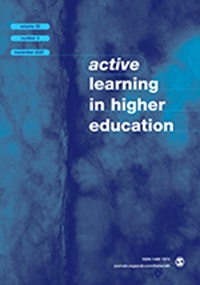Student perceptions: How virtual student-led talking circles promote engagement, social connectedness, and academic benefit
IF 3.8
1区 教育学
Q1 EDUCATION & EDUCATIONAL RESEARCH
引用次数: 1
Abstract
Many expect upward trends in online college course enrollment to continue. Despite perceived improvements in online pedagogical practice and advantages afforded by virtual platforms, most students and professors still perceive social interaction, engagement, and overall learning to be more challenging online than in person. More than 3 in 10 college students are less willing to participate in discussions online compared to in person. More than 7 in 10 professors report needing help with strategies for keeping students engaged online. As such, we must identify strategies that cater to students’ academic, and social-emotional needs in an online environment. Breakout rooms have often been implemented to promote discussion and collaboration, however, when not well-structured, they often increase social discomfort instead. In this mixed methods study, using surveys, interviews and class observations, we examine student-led talking circles in an undergraduate adolescent development course ( N = 61), in which student discussion leaders prepared questions and facilitated small group conversations using structured turn-taking protocols. Nearly 95% of students felt talking circles increased peer connectedness, 92% felt they improved content learning, and 90% felt they increased engagement. Students largely attributed these benefits to specific elements of the talking circle format. Regression results revealed significant associations between peer connectedness and perceived academic benefit, after accounting for demographics, basic psychological needs, dispositional factors, and norms of communication.学生的看法:虚拟的学生主导的谈话圈如何促进参与,社会联系和学术利益
许多人预计在线大学课程招生人数将继续呈上升趋势。尽管在线教学实践有所改善,虚拟平台也提供了优势,但大多数学生和教授仍然认为,在线社交、参与度和整体学习比面对面更具挑战性。与面对面讨论相比,超过十分之三的大学生不太愿意在网上参与讨论。超过十分之七的教授表示,在保持学生在线参与的策略方面需要帮助。因此,我们必须确定在网络环境中满足学生学术和社会情感需求的策略。休息室通常被用来促进讨论和合作,然而,如果结构不好,它们往往会增加社交不适。在这项混合方法的研究中,使用调查、访谈和课堂观察,我们在一门本科生青少年发展课程中考察了学生主导的谈话圈子(N = 61),其中学生讨论领导者准备问题,并使用结构化的轮流发言协议促进小组对话。近95%的学生认为谈话圈增加了同伴之间的联系,92%的学生认为他们改善了内容学习,90%的学生认为自己增加了参与度。学生们在很大程度上将这些好处归因于谈话圈形式的特定元素。回归结果显示,在考虑了人口统计学、基本心理需求、性格因素和沟通规范后,同伴联系与感知的学术利益之间存在显著关联。
本文章由计算机程序翻译,如有差异,请以英文原文为准。
求助全文
约1分钟内获得全文
求助全文
来源期刊

Active Learning in Higher Education
EDUCATION & EDUCATIONAL RESEARCH-
CiteScore
13.20
自引率
12.00%
发文量
31
期刊介绍:
Active Learning in Higher Education is an international, refereed publication for all those who teach and support learning in higher education (HE) and those who undertake or use research into effective learning, teaching and assessment in universities and colleges. The journal is devoted to publishing accounts of research covering all aspects of learning and teaching concerning adults in higher education. Non-discipline specific and non-context/country specific in nature, it comprises accounts of research across all areas of the curriculum; accounts which are relevant to faculty and others involved in learning and teaching in all disciplines, in all countries.
 求助内容:
求助内容: 应助结果提醒方式:
应助结果提醒方式:


